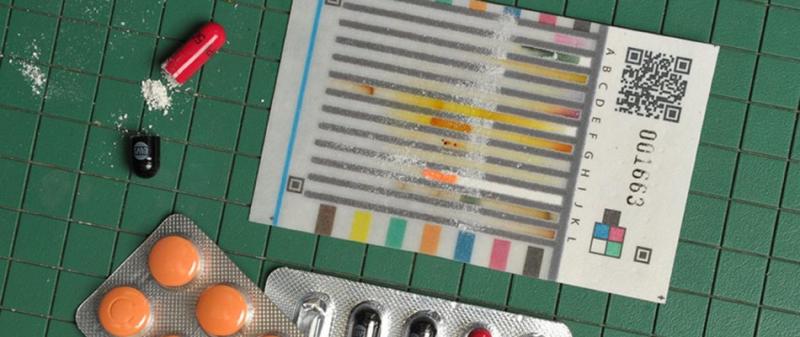Over 10 years experience of Traceability Solutions

By pharmatrax
Category: News
 No Comments
No Comments
Counterfeit or degraded drugs are a significant problem across the globe, particularly in impoverished areas. According to a study from the World Health Organization, about 10 percent of medical products in low-and-middle income countries are either outright falsified or substandard.
Researchers from the University of Notre Dame have developed a possible solution—a novel test card known as a paper analytical device (PAD) that can be used to quickly ‘read’ a pill—much like a barcode—and alert the user of its contents, allowing them to tell whether it is real, fake or contains degraded ingredients. The user simply swipes a sample of the pharmaceutical across the paper card and then dips it in water to activate the test.
Marya Lieberman, one of the creators of PAD and a professor of chemistry and biochemistry at Notre Dame outlined the innovation in the talk, “Overcoming Technological and Resource Limitations to Provide Safe Drugs” at the American Association for the Advancement of Science (AAAS) annual meeting on Feb. 15, 2019 in Washington D.C.
There is currently no global system to monitor the quality of medicine, and countries in the developing world do not have the infrastructure or the regulatory resources to really handle this issue and remove low quality or outright fake medicine off the market shelves, explained Lieberman during her talk at AAAS.
“These problems that I’m talking about are more severe in low-to-moderate income countries, but we are all one world and everybody’s connected,” said Lieberman. “The problems here are nearly two-fold, the first is that a human being can’t really look at a pill and decide whether it is good quality or bad quality. You can’t see inside the pill. Contributing to this is the fact that there is limited resources for doing confirmatory analysis.”
As a result, there is also very little incentive for manufacturers to self-regulate themselves.
“The impact is that manufacturers who don’t play by the rules or who are negligent are actually getting a leg up in the market and that’s not fair,” said Lieberman.
Lieberman said that the PAD test will enable doctors, pharmacists and regular individuals to quickly test whether a medication being sold is actually what it is being marketed as.
The PAD test does not require power, chemicals, solvents or expensive instruments, meaning that it can be rapidly deployed at a large scale even in lower income areas.
The card contains 12 lanes with all the reagents required to carry out tests for different chemicals and functional groups.
For example, one lane contains copper and a base to give a characteristic forest-green color with any beta-lactam type antibiotic. That copper lane gives a different, and distinctive, color with metformin, which is a diabetes medication, and another lane contains a series of reagents that generate a reactive species that can detect phenol groups, found in drugs like acetaminophen or amoxicillin.
Other lanes specialize in detecting inert fillers like maize meal, or substitute drugs like acetaminophen that might be added to replace a more expensive medication.
To use the paper screening tests, the user only needs the actual medicine and water. The card will store the reagents, mix them in the correct order and bring them to the drug sample.
“There is a color barcode that you’re comparing and you can compare a good quality sample or a reference standard with a mystery sample that you just purchased in a shop and decide whether the match is good or not,” Lieberman said. “If you have a cheap, fast field test, then it opens up some new avenues that citizen scientists can now participate in the challenge of keeping the drug supply good.”
Each paper card contains a library of chemical color reactions that is each isolated in its own reaction lane by hydrophobic barriers that are printed onto the card using Whitesides-type wax printing. The card is made of Ahlstrom 319 chromatography paper, a heavy paper made of pure cellulose fibers. A QR code, color standards and lane labels are then printed onto the card and a Xerox ColorQube wax printer use to print the lines that separate the 12 lanes.
A quick bake makes the wax soak into the paper and a Biomek spotting robot is used to place spots on the different reagents into the lane. Thus far, the researchers have printed out 15,000 test cards.
To test the new device, the researchers trained 20 regional drug inspectors in Tanzania. They then provided the inspectors with 3,000 samples, only half of which were real. According to Lieberman, the inspectors using the PAD cards were able to detect fakes with a 93 percent accuracy.
While the card has proven effective, Lieberman did say that at this time it does not read certain drugs currently on the market. She also said the researchers are collaborating directly with medical regulatory agencies to help them discover poor quality medications on the market.
Lieberman pointed to the 2012 fake medicine crisis in Pakistan–where a heart medicine called Isotab killed more than 200 people— as proof that a portable and inexpensive test to spot fake drugs is needed. In this incident, one batch of the drug was manufactured using toxic quantities of an antimalarial medicine in place of the inert filler that was supposed to be added. The Pakistani government believes that the drug got wet during delivery and was ultimately moved into a drum that was previous marked “Starch.”
Lieberman said the next step will be to scale-up production of the PAD cards.
“Right now we are making them in my lab and we’ve made about 30,000 cards in the last four years,” she said. “We believe that we can crank that up in the lab but there is a start-up company that’s formed, so we are trying to transfer the technology.”
Source: https://www.rdmag.com/article/2020/02/paper-test-spots-fake-degraded-pharmaceuticals